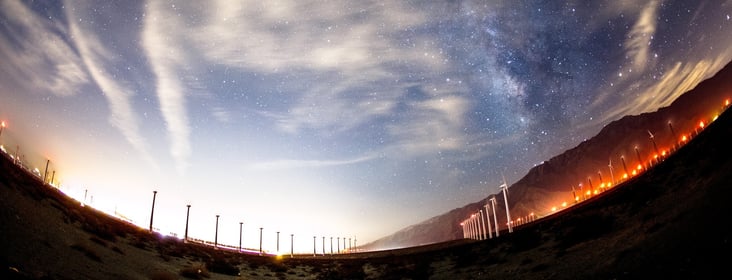
This week we saw wind turbines reaching heights, new opportunities for energy storage in California, and the grid’s “best kept secret.” (Spoiler: it’s Combined Heat and Power, but that’s apparently not sexy enough for your average consumer). But let’s begin this week in Iowa, where time-lapse footage from MidAmerican Energy gives us a look into the construction of the tallest wind turbine ever built in the United States. Working night and day, construction crews build the turbine, which has a capacity of 2.4 MW. And you can see it put together in just 5 minutes and 42 seconds!
MidAmerican partnered with AEE member Siemens Americas’ Onshore Wind division to build the tower, which is two feet taller than the Washington Monument, when measured from the ground to the tip of its blade. Vox reports that the U.S. has largely been left behind on the latest (read: biggest) wind turbine construction. One reason, David Roberts writes, is that U.S. wind resources are stronger – frankly, there’s just more and stronger wind on the Great Plains, so there’s less need for turbines to reach higher.
Another reason, though, is transportation – U.S. road infrastructure (bridge height and road width) wasn’t built to accommodate these marvels of modern engineering. And in the U.S. they often have to travel further. Additionally, European “average tower height” includes offshore wind turbines, which don’t have to deal with the same transport challenges, and are, frankly, enormous. But as the U.S. gets ever closer to kick-starting our offshore wind industry, it’s nice to know we’re catching up on land, as well as by sea. (And it’s working. In addition to the wind generation records set in Texas earlier this year, Sustainable Business reported this week that soon Iowa will run on 40% wind energy.)
Meanwhile, in California, the storage industry may be about to get another bump. California’s 2013 storage mandate for utilities has helped grow the energy storage industry at a fast clip: Revenue from energy storage grew 12 times last year over 2014. It seems as though the Golden State could do it again: Modifications to the state’s Self-Generation Incentive Program (SGIP) propose allowing storage to account for the bulk of the program’s incentive awards. Under the proposed modifications, 75% of the $83 million would go toward storage, with the remaining quarter going toward generation.
As Utility Dive points out, that might be where the program was headed to begin with. The bulk of the recipients of SGIP dollars have been energy storage and fuel cell companies, namely AEE members Bloom Energy and Stem. The modifications would replace the first-come, first-served process with a lottery system aimed at leveling out the playing field for companies that are getting left out – which might have the effect of helping to build the non-solar distributed generation market in California (solar was moved from SGIP into the California Solar Initiative in 2006).
It’s not just California that’s adopting storage – Greentech Media this week reports that storage is expanding in emerging markets in Kentucky, Nevada, Utah, and Vermont. The first quarter of 2016 continued the incredible growth trend in storage, with 1.3 MW of residential energy storage deployed in the United States. As more states (like Arizona) begin to consider demand charges, this could open up new opportunities for storage.
In national news, this week the Federal Energy Regulatory Commission (FERC) initiated a formal inquiry into barriers to participation of energy storage in regional electricity markets. Greentech Media covered the Energy Storage Association’s filed comments in, “7 Ways Storage Can Get Fair Play in Energy Markets.” AEE also filed comments applauding FERC’s inquiry, but encouraged the Commission to conduct a separate review of market rules that impede the participation other advanced energy technologies.
“We wholeheartedly applaud this FERC inquiry, as energy storage technology has proven to be a practical and cost-effective resource. We call on FERC to quickly take steps through this inquiry to address the rules that prevent its broader use,” said Arvin Ganesan, vice president for federal policy at Advanced Energy Economy, national business group. “However, since the same challenges exist for a wide variety of other technologies, we urge FERC to identify the barriers to participation in wholesale markets that are facing all advanced energy technologies.”
We identified three ways that to ensure that ALL advanced energy technologies (including storage) get fair play in the market:
- Defining eligibility to participate in the market based on resource type as opposed to what a technology can do, thereby banning from competition new technologies that accomplish the same purpose,
- Effectively requiring that all participating resources resemble traditional power plants, thereby excluding a resource like energy storage simply because it is unavailable when recharging, and
- Characterizing all technologies installed behind the customer meter that participate in markets only as “demand response,” even if they are not primarily load reduction measures, thereby preventing resources like onsite storage, solar, and fuel cells from providing a broader set of services to the grid.
Download our full comments here.
Finally, from Utility Dive, we got a special report on Combined Heat and Power (CHP), which UD called the grid’s “best kept secret.” These systems produce useful heat and electricity from the same fuel source in an integrated system – meaning they are much more efficient than your average power plant. The problem, according to Mei Shibata, an analyst with GTM Research, might be marketing. “Solar companies have done such a good job marketing themselves that anything fuel-based, people just aren't in the mood to hear about it [CHP],” Shibata said.
I’m not sure why – it’s got heat, it’s got power, it’s got those two things combined; it’s right there in the name! Learn more about CHP and how it’s often the best and most reliable way for a large facility to remain online even in the face of tremendous storms in our report This is Advanced Energy, which covers CHP and 51 other sexy, exciting advanced energy technologies.
